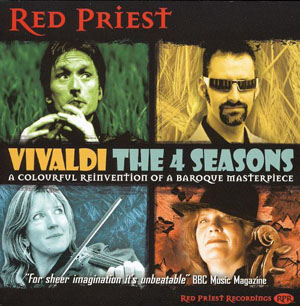 Antonio Vivaldi’s The Four Seasons, which, although actually four concerti grossi is invariably performed as a single work, was one of the most popular works in the baroque canon in the years after its creation in 1723, and after Vivaldi’s reinstatement in the twentieth century as a composer of distinction has once again taken its place as a favorite. In brief, the work is an early example of “programmatic” music — the program being the seasons and life in the country, something that seemed to hold a certain fascination for the eighteenth-century upper crust (as witness the enthusiastic reception of Franz Josef Haydn’s own The Seasons).
Antonio Vivaldi’s The Four Seasons, which, although actually four concerti grossi is invariably performed as a single work, was one of the most popular works in the baroque canon in the years after its creation in 1723, and after Vivaldi’s reinstatement in the twentieth century as a composer of distinction has once again taken its place as a favorite. In brief, the work is an early example of “programmatic” music — the program being the seasons and life in the country, something that seemed to hold a certain fascination for the eighteenth-century upper crust (as witness the enthusiastic reception of Franz Josef Haydn’s own The Seasons).
The notes accompanying this disc note that, since Vivaldi himself was “a maverick and a showman,” the members of the baroque ensemble Red Priest (Piers Adams, recorders; Julia Bishop, violin; Angela East, cello; and Howard Beach, harpsichord) chose to “cast aside the rulebook.” The result is, to say the least, refreshing. And for those wondering, the ensemble named itself after Vivaldi, who was a redhead and a priest.
In part this is the result of the size of the ensemble — Vivaldi is usually performed by larger groups, small orchestras in fact — and the instrumentation. Adams’ recorders, in particular, lend a radically different flavor to the music. There are sections in which the “country” flavor comes through strongly — the violin becomes a fiddle, and there’s a rustic air that Vivaldi probably would have been delighted with. Another very noticeable feature of Red Priest’s interpretation is tempos — they are quite often fast and furious, particularly noticeable in sections such as the opening allegro in “Autumn” and the allegro non molto in “Winter.” It gets pretty lively, but what’s most arresting is the precision of the performance, most apparent in those passages, but, as one realizes after further listening, much in evidence throughout. The players are right together on this one. The ensemble has created a kind of leanness here that highlights the structure — and this piece has, as they say, “great bones.”
Arcangelo Corelli’s Concerto Grosso Op. 6, No. 8 (The “Christmas” Concerto) has long been one of my favorite baroque works, and everything I said about Red Priest’s approach to Vivaldi holds true of Corelli as well, with the addition of some tricks with rhythm that I’ve never heard before and that add a new dimension to the work, as do the particular tonal colors that the group creates. In places the music registers so much differently than what I’ve been used to that it took me a moment to realize that this delightful piece of music was indeed the old warhorse I’ve loved all these years.
Even if, like me, you’ve already got a recording of these baroque standards, trust me — you’ll have room for this one.
(Red Priest Recordings, 2009)
